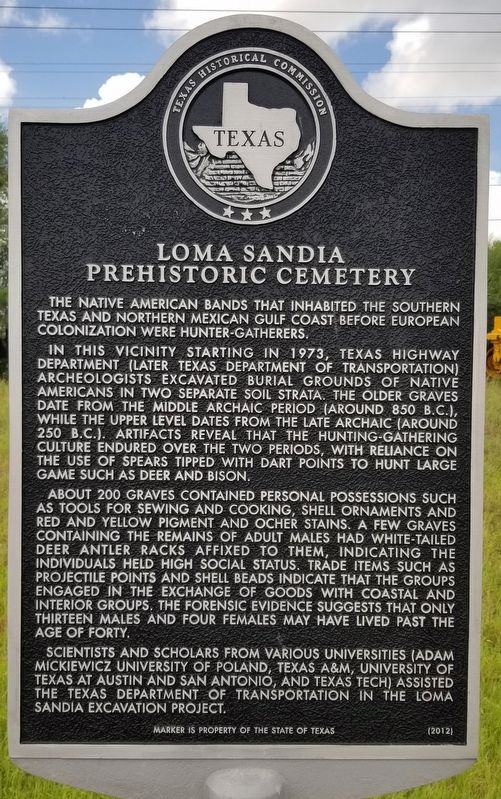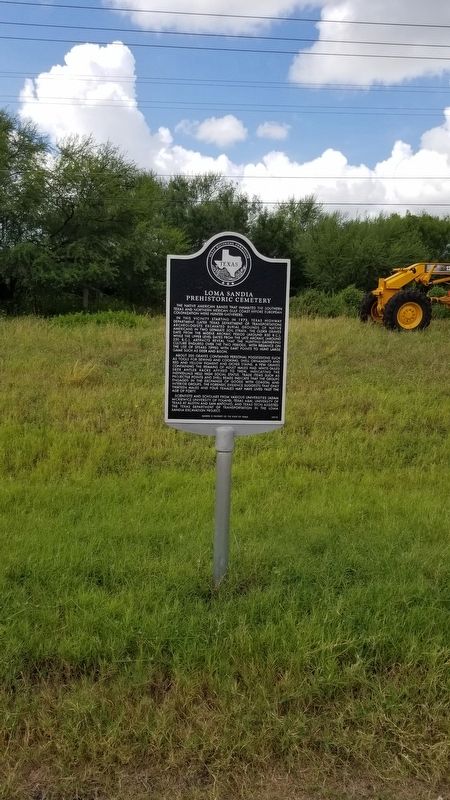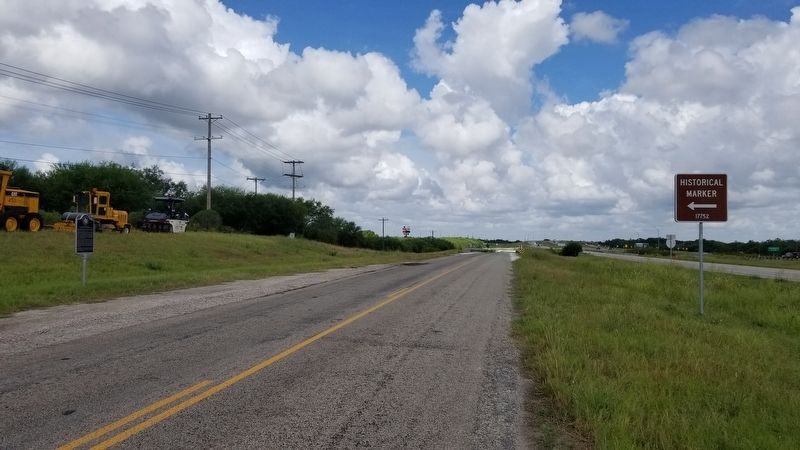Near Three Rivers in Live Oak County, Texas — The American South (West South Central)
Loma Sandia Prehistoric Cemetery
About 200 graves contained personal possessions such as tools for sewing and cooking, shell ornaments and red and yellow pigment and ocher stains. A few graves containing the remains of adult males had white-tailed deer antler racks affixed to them, indicating the individuals held high social status. Trade items such as projectile points and shell beads indicate that the groups engaged in the exchange of goods with coastal and interior groups. The forensic evidence suggests that only thirteen males and four females may have lived past the age of forty.
Scientists and scholars from various universities (Adam Mickiewicz University of Poland, Texas A&M, University of Texas at Austin and San Antonio, and Texas Tech) assisted the Texas Department of Transportation in the Loma Sandia Excavation Project.
Erected 2012 by Texas Historical Commission. (Marker Number 17752.)
Topics. This historical marker is listed in these topic lists: Cemeteries & Burial Sites • Native Americans. A significant historical year for this entry is 1973.
Location. 28° 31.02′ N, 98° 10.636′ W. Marker is near Three Rivers, Texas, in Live Oak County. Marker is on Frontage Road (Interstate 37) one mile south of U.S. 281, on the right when traveling south. The marker is located just off the frontage road of I-37. Touch for map. Marker is in this post office area: Three Rivers TX 78071, United States of America. Touch for directions.
Other nearby markers. At least 8 other markers are within 4 miles of this marker, measured as the crow flies. Site of Three Rivers Glass Factory (approx. 3.9 miles away); Felix Longoria (approx. 3.9 miles away); Jessy Franklin Gray (approx. 3.9 miles away); Three Rivers (approx. 3.9 miles away); First State Bank Building (approx. 3.9 miles away); Rialto Theater (approx. 3.9 miles away); James and Sara Cunningham House (approx. 3.9 miles away); Early Schools in Live Oak County (approx. 4 miles away). Touch for a list and map of all markers in Three Rivers.
Also see . . .
1. Loma Sandia.
The cemetery predates by approximately 2,000 years the first European explorer and historian, Álvar Núñez Cabeza de Vaca, who traveled through South Texas and northern Mexico and later published an account of his adventure. The Coahuiltecan natives Cabeza de Vaca encountered made annual forays into the area to eat the succulent cacti tunas and pecans from trees along the Nueces River. Tubers, small creatures, earth substances, and occasional larger animals also contributed to their meager diet. Cabeza de Vaca’s report of the area and native life was so descriptive that he is regarded as Texas’s first ethnologist. Source: The Handbook of Texas(Submitted on September 2, 2021, by James Hulse of Medina, Texas.)
2. American Indians.
Ethnologists have identified hundreds of groups of Texas "Indians," as the first European explorers to arrive called the peoples they found. Some of these were true tribes, accumulations of families or clans with social customs, traditions, and rules for order; these were occasionally quite large. At the opposite extreme, some were merely small family groups whose names or ethnic designations were taken for "tribal" names by the Spanish and French and in subsequent secondary literature. The extant names of Texas Indian groups present a dazzling array of variants, partly because the Spanish, French, and English heard the newly "discovered" peoples differently and recorded their names differently. Some names in the historical records are mistakes for groups that never existed. Source: The Handbook of Texas(Submitted on September 2, 2021, by James Hulse of Medina, Texas.)
Credits. This page was last revised on September 2, 2021. It was originally submitted on September 2, 2021, by James Hulse of Medina, Texas. This page has been viewed 464 times since then and 57 times this year. Photos: 1, 2, 3. submitted on September 2, 2021, by James Hulse of Medina, Texas.


